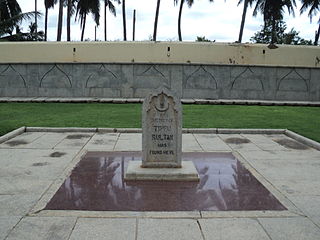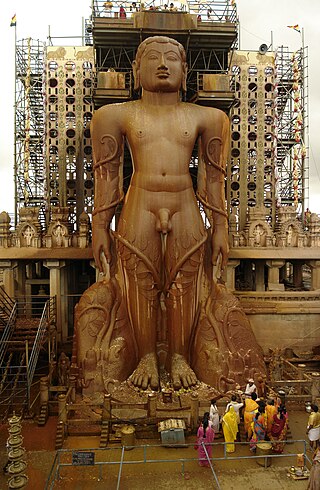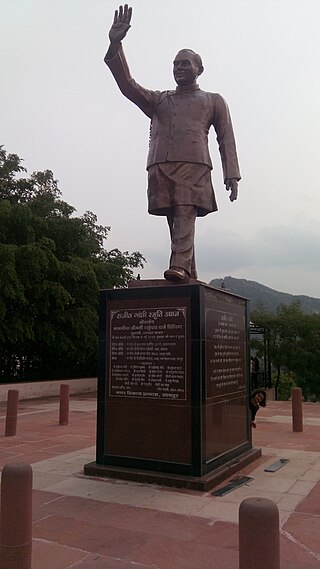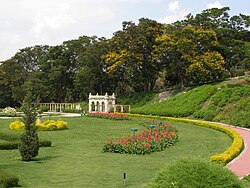
Mysore, officially Mysuru, is a metropolitan city in the southern Indian state of Karnataka. It is the state's third-most populous and is one of the cleanest cities in India according to Swachh Survekshan. It is the seat of the Wadiyar dynasty and was the capital of the Kingdom of Mysore for almost six centuries, from 1399 until 1947. It is currently the headquarters of Mysore district and Mysore division. Known for its heritage structures and palaces, including the famous Mysore Palace, and noted for its culture, Mysore is popularly known as the "City of Palaces", the "Heritage City", and the "Cultural Capital of Karnataka". For its pristine and calm ambience, it is also known as "Pensioners' Paradise".

Krishna Raja Sagara, also popularly known as KRS, is a lake and the dam that creates it. They are close to the settlement of Krishna Raja Sagara in the Indian State of Karnataka. The gravity dam made of surki mortar is below the confluence of river Kaveri with its tributaries Hemavati and Lakshmana Tirtha, in the district of Mandya.

Lalbagh Botanical Garden or simply Lalbagh, is an botanical garden in Bangalore, India, with an over 200-year history. First planned and laid out during the dalavaiship of Hyder Ali, the garden was later managed under numerous British Superintendents before Indian Independence. It was responsible for the introduction and propagation of numerous ornamental plants as well as those of economic value. It also served a social function as a park and recreational space, with a central glass house dating from 1890 which was used for flower shows. In modern times, it hosts two flower shows coinciding with the week of Republic Day and Independence Day. As an urban green space along with Cubbon Park, it is also home to numerous wild species of birds and other wildlife. The garden also has a lake adjoining a large rock on which a watchtower had been constructed during the reign of Kempegowda II.

Mysore district, officially Mysuru district, is an administrative district located in the southern part of the state of Karnataka, India. It is the administrative headquarters of Mysore division. Chamarajanagar District was carved out of the original larger Mysore District in the year 1998. The district is bounded by Chamrajanagar district to the southeast, Mandya district to the east and northeast, Kerala state to the south, Kodagu district to the west, and Hassan district to the north.

The Mettur Dam is one of the largest dams in India and also the largest in Tamil Nadu, located across the river Kaveri where it enters the plains. Built in 1934, it took 9 years to complete. Maximum height and width of the dam are 214 and 171 feet, respectively. The dam receives inflows from its own catchment area, Kabini Dam and Krishna Raja Sagara Dams located in Karnataka. There is a park at the base of the dam called Ellis Park maintained by the Tamil Nadu Public Works Department. It provides irrigation and drinking water facilities for more than 12 districts of Tamil Nadu and hence is revered as the life and livelihood-giving asset of Tamil Nadu.

Ranganathittu Bird Sanctuary, is a bird sanctuary in the Mandya District of Karnataka in India. It is the largest bird sanctuary in the state, 40 acres (16 ha) in area, and comprises six islets on the banks of the Kaveri river. The sanctuary has been designated on 15 February 2022 as a protected Ramsar site since 2022.

Mandya district is an administrative district of Karnataka, India. The district is bordered on the south by Mysore and Chamarajangar districts, on the west by Hassan district, on the north by Tumkur district and on the east by Ramanagara district. The district Mandya was carved out of larger Mysore district in the year 1939.
Krishnarajasagara is a town in Mandya district in the Indian state of Karnataka.

The sharing of waters of the Kaveri River has been the source of a serious conflict between the two Indian states of Tamil Nadu and Karnataka. The genesis of this conflict rests in two agreements in 1892 and 1924 between the Madras Presidency and Kingdom of Mysore. The 802 kilometres (498 mi) Kaveri river has 44,000 km2 basin area in Tamil Nadu and 32,000 km2 basin area in Karnataka. The annual inflow from Karnataka is 425 TMCft (12 km3) whereas that from Tamil Nadu is 252 TMCft (7.1 km3).
The Upper Krishna Project (UKP) is an irrigation project across the Krishna River to provide irrigation to the drought-prone areas of Vijayapura district, Karnataka, Bagalkot, Kalburgi, Yadgir and Raichur districts in the state of Karnataka in south India. The project had been designed by the Government of Karnataka to irrigate 1,536,000 acres of land (6,220 km2).

Karnataka, the sixth largest state in India, has been ranked as the third most popular state in the country for tourism in 2014. It is home to 507 of the 3600 centrally protected monuments in India, second only to Uttar Pradesh. The State Directorate of Archaeology and Museums protects an additional 752 monuments and another 25,000 monuments are yet to receive protection.
The Kingdom of Mysore was a kingdom in southern India traditionally believed to have been founded in 1399 in the region of the city of Mysore in Karnataka. For the most part, the Wodeyar dynasty ruled the southern Karnataka region until the kingdom united with the Dominion of India in 1947. During the kingdom's history, it went through various phases of administration, with increasing foreign influence from the eighteenth century.

State Highway 17 (SH-17) is a state highway connecting the cities of Bangalore and Mysore in the south Indian state of Karnataka. The highway has a total length of 149 kilometres (93 mi). It was built and maintained by the Karnataka Road Development Corporation Limited and inaugurated in 2003. The highway passes through the towns of Ramanagara, Channapatna, Maddur, Mandya and Srirangapatna (Seringapattinam), before entering Mysore. The road is dual carriageway and passes over the Kaveri river. The 15 km stretch from Bangalore Central to Kengeri NICE Road Junction is known as Mysore Road.

Hebbal is an industrial area and suburb of Mysore city in India.

Mysuru City Corporation (MCC) is the administrative body responsible for civic amenities and infrastructural assets of Mysuru in Karnataka, India. It is the third-largest municipal corporation in Karnataka, serving a population of 1,000,000 in an area of 235 km2. The city's boundaries have expanded more than twice between 2010 and 2020.

Basava Sagar Dam, previously known as Narayanpura Dam, is a dam constructed across the Krishna River at Yadgir District, Karnataka State, India. The reservoir that it impounds is known as Basava Sagar, and has a total storage capacity of 37.965 tmcft (1.075 km³), with 30.5 tmcft (0.85 km³) live storage. The full reservoir level is 492.25 m MSL and the minimum draw down level is 481.6 m MSL. It was a single purpose project meant only for irrigation, but downstream electrical generation and drinking water considerations enter into its management. The dam is 29 meters high and over 10.637 kilometres (6.610 mi) long, and has 30 gates for water release. 22 Spillway Gates are present in the Dam It took Rs. 50.48 crore to complete.
Kaveri Grameena Bank was a Regional Rural Bank established under Regional Rural Banks' Act 1976, was a Scheduled Bank jointly owned by Government of India, State Bank of India and Government of Karnataka, permitted to carry all kinds of banking business. The Bank was operating in 22 Districts of South Karnataka, having its Head Office at Bellary City with Nine Regional Offices at Mysuru, Mandya, Bengaluru, Tumakuru, Hassan, Chamarajanagar, Madikeri, Chikmagulur and Ramanagara etc.

Rajiv Gandhi Garden is one of the big gardens in Udaipur, Rajasthan, India. It is situated near the back of Fateh Sagar Lake, and contains a statue of Late Rajiv Gandhi, besides several other attractions like spacious children's park and a food court.



































